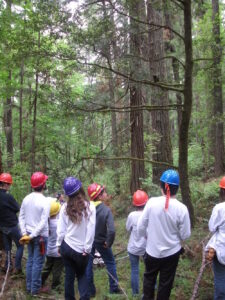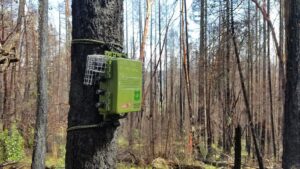Life isn’t easy for the northern spotted owl, an endangered species native to the Pacific Northwest. As researchers try to track these birds and save them from wildfires, loggers, and other predators, they face a difficult question: How do you identify and track a nocturnal species in the dense thicket of the forest when it’s barely light out?
Autonomous recording units (ARUs)—a form of bioacoustics—are allowing biologists in California and Oregon to track northern spotted owls through their songs by placing microphone-equipped recording devices on trees and then using artificial intelligence (AI) to find patterns in sound files. The technology reduces the chance of human error, improves accuracy, and saves time. Biologists can then take the data from the recordings and use it to identify long-term trends in the spotted owl population.

“With bioacoustics, we can not only do a better job of understanding what’s happening with the owls and the effects of different disturbances, but we can also do it a lot less invasively,” says Damon Lesmeister, a wildlife biologist with the U.S. Forest Service in the Pacific Northwest.
Bioacoustics have already been used for whales and bats, and it is turning out to be especially effective for studying birds and raptors. Biologists hope that bioacoustics can help save the northern spotted owl, as well, whose existence is under growing threat. By listening to the northern spotted owls on ARUs, these scientists can more accurately track the owl’s population with less human interference and gain valuable insights that may help stop the species from going extinct.
Threats to the northern spotted owl population
The population of the northern spotted owl, designated endangered since 1991, is in steep decline, dropping at an average annual rate of 3.8 percent. There are no current estimates of the total population size of northern spotted owls because many areas still remain unsurveyed, according to the department.
Unfortunately, the amount of suitable habitat available to spotted owls, which prefer to nest in old forests and tree holes, has been reduced by over 60 percent in the last 190 years, due in large part to timber harvesting and wildfires. Another threat facing the northern spotted owl is the barred owl, a closely related species that’s more territorial. “The barred owl is more aggressive and literally out-competes and almost bullies spotted owls out of their nesting areas and habitats,” says Dave Press, a wildlife ecologist with the National Park Service who monitors the northern spotted owl in Point Reyes, California.
The barred owl is more aggressive and literally out-competes and almost bullies spotted owls out of their nesting areas and habitats.
—Dave Press, wildlife ecologist
The presence of a barred owl makes it difficult to detect a spotted owl, further challenging biologists to properly identify and track the species. “When barred owls are present, the spotted owl goes quiet,” Press says. “They don’t want to tell the barred owl where they are.”
This is why researchers have struggled with traditional field research. If the spotted owl remains quiet—fearing an attack from a barred owl—researchers who call out to them in the forest won’t receive an answer, neither will land managers who need to know where owls are when they’re logging. Usually, when loggers decide where to cut down trees, they call into the forest by mimicking a spotted owl call to see if any spotted owls respond (known as a “callback survey”). If the spotted owls don’t respond, timber companies often assume that it’s a safe area and begin cutting down trees. Because spotted owls prefer to nest in old trees, cutting down trees would hurt their habitat.

“My fear is that it’s a contributing factor to [dwindling] spotted owl populations,” Lesmeister says. By using ARUs, “we can at least reduce or eliminate one of the stressors on the spotted owl population: the callback surveys.”
ARUS can more effectively eavesdrop on the northern spotted owl and record their hoots. Both Press and Lesmeister are using the technology to gauge the spotted owl populations in their territories.
How ARUs detect owl hoots
The ARU battery-powered recording devices, made by Wildlife Acoustics, are about the size of a small backpack and equipped with a high-quality microphone. Researchers attach them to trees where they record the hoots of both northern spotted owls and barred owls during dusk and dawn, the time when owls are most vocal.
The recording distance of each unit varies, Lesmeister says, but it’s roughly equivalent to the distance and range of what a human can hear, though it can vary a lot, depending on where the device is placed. “If you’re in the bottom of a valley, or near a noisy stream or dense vegetation, you can’t hear very far,” he says, noting that when they deploy the ARUs, they place them on the mid-slope or upper slope of a mountain or hill and avoid loud environments.
“The advantage is that the ARU is standing out there for six weeks, whereas, of course, humans can’t do that,” Lesmeister says. “And so we’re really taking these devices and leveraging this technology to be able to increase the amount of time that we’re sort of doing a survey in a particular place.”
Each ARU device is equipped with a memory card that researchers take back to the office for analysis. Once downloaded onto an external hard drive, researchers use Kaleidoscope software to scan the audio files for barred and spotted owl calls. The software converts the owl calls into spectrograms, a visual representation of sound that can be likened to a signature.

Lesmeister and his team trained the Kaleidoscope software to recognize and identify a spotted owl spectrogram and likened it to the kind of image recognition frequently used on smartphones and social media. To help ensure accuracy, a team of trained technicians validates each instance to confirm that the sound was indeed a spotted owl. Then they use that data to create records of when and where the ARU picked up the owl call.
Without AI, we just couldn’t do this work—it just wouldn’t be feasible. In my lab alone, we have over two million hours of sound recordings. I don’t know how many people that would take to actually go through them.
—Damon Lesmeister, wildlife biologist
AI has been a “game-changer,” Lesmeister says, noting that researchers can spend far less time than if they sat and listened to each recording manually. “Without AI, we just couldn’t do this work—it just wouldn’t be feasible. In my lab alone, we have over two million hours of sound recordings. I don’t know how many people that would take to actually go through them, but it’s prohibitively expensive, as you can imagine.”
Tracking and protecting the northern spotted owl
Having valuable sound data from ARUs enables researchers to track spotted owl populations and learn whether the numbers are going up, down, or remaining flat over time. “As a listed species, under the endangered species act, we have to track that and understand it,” Press says.

Another way that ARUs are being used is to assess the impact of wildfires. In fact, Lesmeister is currently looking at how the 2020 Pacific Northwest wildfires affected owls and other animal populations by determining to what extent species decide to return to burned territory; little is known about how owls respond to wildfire, and learning more can help provide important insights if fires increase in size and severity due to climate change.
“We’re doing work right now with bioacoustics to evaluate the effect of those fires on not only spotted owls but a whole range of other species,” Lesmeister says. “I think there’s a very bright future and a big role that technology will play in the future of wildlife conservation.”
Lead photo of a northern spotted owl by Damon Lesmeister.